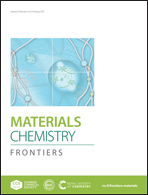New multifunctional benzophenone-based photoinitiators with high migration stability and their applications in 3D printing†
Abstract
In this paper, seven new photoinitiators based on the benzophenone scaffold are specifically designed for photopolymerization under mild conditions upon light-emitting diode (LED) irradiation, i.e. four benzophenone-triphenylamine photoinitiators (denoted as BT1–BT4) and three benzophenone-carbazole photoinitiators (denoted as BC1–BC3). Noticeably, these structures have never been reported in the literature except for BT4, so these molecules have been specifically designed for photopolymerization applications. Remarkably, various combinations of chemical groups were investigated in this work to determine the effects of the substitution patterns on their photoinitiation abilities. The formation of benzophenone-triphenylamine and benzophenone-carbazole hybrid structures not only contributes to red-shift of the absorption maxima but also strongly enhances their molar extinction coefficients. The different compounds showed high photoinitiation abilities upon irradiation with an LED@405 nm, and the free radical photopolymerization of acrylates and the cationic polymerization of epoxides could be promoted with high final function conversions (e.g. 77% for the BT3/iodonium salt/amine system in free radical photopolymerization). Remarkably, these new PIs are also able to sensitize sulfonium salts upon irradiation @405 nm. Markedly, because of the benzophenone moiety, a monocomponent Type II PI behavior could be observed, e.g. these compounds could initiate the polymerization alone. Remarkably, benzophenone-triphenylamine compounds BT2, BT3 and BT4 exhibited better hydrogen abstraction abilities as Type II photoinitiators than the benchmark and commercial photoinitiator 2-isopropylthioxanthone in the absence of amines as well as in the presence of amines. Furthermore, the interaction between the photoinitiators and the different additives was investigated by steady state photolysis and fluorescence quenching experiments. The free radical generation in the BT3/amine system was confirmed by the electron spin resonance-spin trapping technique, and the chemical mechanisms related to the polymerization efficiency are discussed. In addition, the migration stability of BT3 was investigated, which was excellent due to its high molecular weight and its trifunctional character. Finally, the three-component photoinitiating system based on BT3 was successfully applied in 3D printing and the 3D patterns showed a good spatial resolution.



 Please wait while we load your content...
Please wait while we load your content...